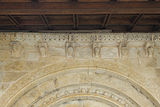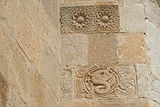Santa María (Almenara de Tormes)
The Catholic parish church of Santa María in Almenara de Tormes , a municipality in the province of Salamanca in the Spanish autonomous region of Castile and León , was probably built in the second half of the 12th century. The Romanesque church has two richly carved round arch portals and an apse decorated with friezes . In 1993 the church was declared a monument ( Bien de Interés Cultural ).
history
The name of the place Almenara is the Arabic name for a watchtower that was located on a small hill above the river Tormes and that was demolished at the beginning of the 14th century. In 1164 King Ferdinand II of León donated the place to the cathedral chapter of Salamanca. It is believed that construction of the church began around this time. In the 16th century the church was enlarged and two side chapels were added . The apse was given a ribbed vault and the large window was broken through in the Baroque period .
North portal
The portal of the north facade is framed by four archivolts . The first and third archivolt rest on pilasters , the second and fourth archivolt on short three-quarter pillars , which are decorated with ornate capitals . Large leaves curled at the tips with small heads protruding from between them are depicted on three capitals. The capital on the far right shows two figures with long dresses, one figure is also dressed in a wide cloak and is holding a large, round object in his hands. The warriors above the capitals are decorated with a frieze of leaf rosettes, on the left they are bordered by a zigzag band and on the right by a dew band .
The inner arch is unadorned. The two archivolts in the middle are decorated with buds or intertwined circles with stylized leaves and flowers. The outer archivolt is set with semicircles from which curled ribbons protrude at the ends.
A canopy is attached over the portal, which rests on stone slabs into which a frieze made of two rows of half-panes is cut. Including six sculpted with human heads are corbels received.
South portal
The south portal, which is similar to the north portal, is protected by a vestibule that was added later. Here, too, the archivolts lie alternately on pillars and pillars. The capitals are decorated with depictions of harpies and sirens . One scene is interpreted as a falconer on horseback, next to it the depiction of a dog with a partridge flying overhead.
apse
On the outer wall of the apse, two rows of friezes have been preserved halfway up. The upper frieze consists of a series of circles notched into the stone, in the middle of which there are flower rosettes with buds. The lower frieze also consists of rosettes with multi-leaf flowers, individual fields also contain depictions of mythical animals such as griffins or a winged dragon. Human heads can be seen on two stones.
inner space
Inside, only the capitals of the triumphal arch are important. They are attributed to the same master who created the exterior decor. They bear depictions of double-headed eagles with very carefully carved plumage. People sit between large, rolled-up leaves with their hands folded over their knees.
literature
- Jaime Cobreros: Las Rutas del Románico en España . Volume 1, Madrid 2004, ISBN 84-9776-010-7 , pp. 236-237.
- Antonio Vinayo Gonzalez: L'Ancien Royaume de Léon Roman . La Pierre-qui-Vire (Zodiaque) 1972, pp. 381-385.
Web links
- Iglesia de Santa María Amigos del Románico (Spanish, accessed April 19, 2013)
Coordinates: 41 ° 3'51.9 " N , 5 ° 49'23.9" W.









